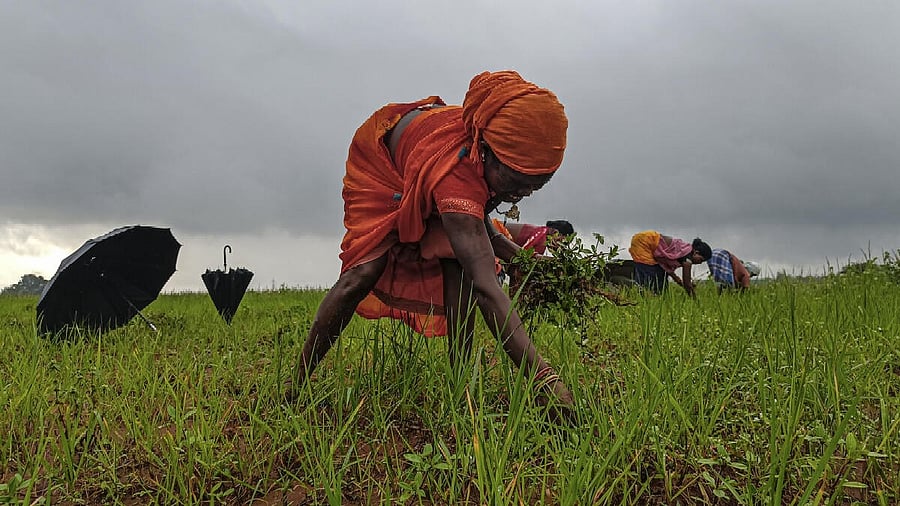
Landless, nameless, essential: The story of India's women farmers
Credit: iStock photo
October 15 is observed by the United Nations as International Rural Women’s Day and in India as Women Farmers’ Day, given the near-synonymity between rural women and women farmers in the country.
The day celebrates their knowledge, skills and resilience and acknowledges their immense contribution to food security and the agricultural sector. It is also a reminder that most of these women still lack recognition and identity as farmers in their own right.
Although the National Policy For Farmers (2007) provided a clear and expansive definition of a "farmer", delinking it from land ownership and thereby including various categories of women farmers, this definition has not been implemented on the ground. Markets and government institutions continue to address themselves mainly to men, as though they alone were farmers.
A large majority of rural women counted as workers in India are engaged in agriculture -- and their numbers are rising. Across regions and crops, women contribute more labour-days than men, sustaining production systems with unrecognised, undervalued and often unpaid labour. Most self-employed women in agriculture work on family-owned land without remuneration, even though new academic evidence shows that such unpaid female labour is crucial to agricultural productivity. At the national level, female land ownership remains extremely low, with wide state-wise variation: according to National Family Health Survey -5 (NFHS-5), only 8.3% of women own land in their name, while the Agriculture Census (2015-2016) records just 13.9% (20.25 million) of operational holdings as being in women's names.
Recent data from the Periodic Labour Force Survey (PLFS) 2024 shows that 76.9% of rural female workers are in agriculture -- up from 76.2% in 2023 and 75.9% in 2022. By contrast, the share of rural men in agriculture has fallen from 51% in 2022 to 49.4% in 2024. The Economic Survey 2024-2025, citing PLFS data, notes that the share of women workers in agriculture rose from 57% in 2017-2018 to 64.4% in 2023-2024, while men’s participation declined from 40.2% to 36.3%. This unmistakably points to the feminisation of Indian agriculture. In some states, such as Chhattisgarh and Himachal Pradesh, women already form the majority of full-time agricultural workers.
Despite this reality, most women farmers still lack a formal identity as farmers, receive unequal pay, and remain disempowered in household, community, and institutional decision-making related to agriculture.
A study by Hema Swaminathan et al., covering Karnataka among other locations, found that men controlled both household and agricultural decisions. Women's participation in decision-making was closely linked to asset ownership -- including land – where they remain significantly disadvantaged. The Karnataka study also concluded that women's economic resources are associated with their decision-making roles.
Despite stronger discourse and some policy articulation on paper, the situation on the ground remains largely unchanged. Even in Adivasi communities, where women traditionally enjoyed higher social status and autonomy, formalising Individual Forest Rights (IFR) titles solely in men's names --in violation of the Forest Rights Act 2006 – has deepened inequalities. Community institutions, which are statutorily mandated to have equal spaces created for women to take part in decision-making, are not being created and used. Meanwhile, gender blind spots in agricultural interventions have caused even progressive initiatives like farmer producer organisations (FPOs) to widen gender gaps. Women face significant barriers to entry, participation, and leadership in FPOs and cooperatives -- issues that remain off the policy radar.
Nor does this account for the many women farmers who are not cultivators -- livestock rearers, pastoralists, forest foragers, and fisherwomen. Together, they face deep structural violence in their daily lives, even as they form the backbone of India's agriculture. This reality demands an explicit acknowledgement and redress.
Governments must begin by maintaining gender-disaggregated data systems for all aspects of agriculture -- credit, insurance, marketing, land and livestock ownership, and membership in various institutions. Without this basic foundation, progress cannot be meaningfully tracked.
Karnataka’s farmer registry, FRUITS, should be replicated nationwide. In fact, the AgriStack’s Farmers’ Registry, being shaped by the Government of India based mainly on land records, risks excluding millions of landless cultivators -- including a vast number of women – unless it explicitly includes non-land-owning farmers.
While patriarchy has placed most assets in men's hands, the least that the Government of India can do is redirect its DBT/DIT schemes to women farmers in agri-households. Progressive policies are also needed to redistribute asset ownership between men and women, with active incentives for gender equity.
While this may take a longer time, it is also important to ensure that food systems transformation towards greater sustainability and justice is led by women farmers. It is not enough that low-paid Krishi Sakhis are made to shoulder the responsibility of extension departments, but that in the highest levels of decision-making, women farmers are given space to articulate their vision for the future of agriculture in India. As the world walks into the year 2026, which has been declared as the International Year of the Woman Farmer by the United Nations, it is hoped that women farmers will get justice on many fronts.
(The writer is with the Alliance for Sustainable and Holistic Agriculture)